
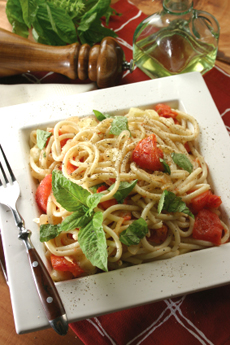 San Marzano tomatoes (here, the whole tomatoes cut up), fresh basil and bucatini (a thick, hollow spaghetti) make a perfect pasta dish. Photo by Gabriel Domenichelli| IST.
San Marzano tomatoes (here, the whole tomatoes cut up), fresh basil and bucatini (a thick, hollow spaghetti) make a perfect pasta dish. Photo by Gabriel Domenichelli| IST.
|
KAREN HOCHMAN is Editorial Director of THE NIBBLE.
|
|
January 2008
|
 |
San Marzano Tomatoes
Perhaps The Most Delicious Tomatoes In The World
CAPSULE REPORT: The San Marzano is an heirloom variety of plum tomato, originally planted in the town of the same name at the base of Mount Vesuvius. The volcanic soil and sunny climate grow tomatoes that are among the most sought-after on earth, with remarkable, sweet, intense tomato flavor. The variety is so good, that a version grown in the U.S., with the generic name San Marzano, is also spectacular—naturally sweet and luscious, with increasingly good distribution. In a marketplace of mediocre tomato sauces, a can of San Marzano tomatoes with absolutely no embellishment can be exquisite. Add some fresh herbs, and enter the gates of heaven. You can go further and add olive oil and garlic for a legitimate sauce; but these tomatoes, served as is, are all the legitimacy one needs. They’re also low calorie—as little as 25 calories per half cup. Be creative in how you use them—think outside the sauce.
Ask any chef what the best tomatoes for sauce are, and you’ll hear a unified chorus: San Marzano—a tomato so distinctive and high quality that it is the only variety that can be used for true Neapolitan pizza. While the varietal is grown in the U.S. and worldwide, it made its name as the tomato grown in the volcanic soil of Mount Vesuvius.
The legend is that the first seeds to become San Marzano tomatoes came to Campania 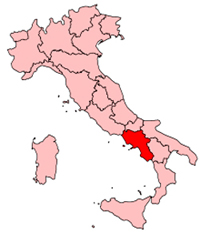 in 1770, as a gift from the Kingdom of Peru to the Kingdom of Naples (the tomato originated in Peru). The seeds were planted in the area that is the present-day commune of San Marzano, a small town southeast of Naples at the base of Mount Vesuvius. The volcanic soil is believed to act as a filter for water impurities, producing a lower-acidity, brighter-flavored tomato. The tomatoes grown in the San Marzano area have the D.O.P. emblem, Denominazione d’Origine Protetta. in 1770, as a gift from the Kingdom of Peru to the Kingdom of Naples (the tomato originated in Peru). The seeds were planted in the area that is the present-day commune of San Marzano, a small town southeast of Naples at the base of Mount Vesuvius. The volcanic soil is believed to act as a filter for water impurities, producing a lower-acidity, brighter-flavored tomato. The tomatoes grown in the San Marzano area have the D.O.P. emblem, Denominazione d’Origine Protetta.
Map of Italy, highlighting the region of Calabria, courtesy of Wikipedia.
Compared to the Roma variety of plum tomato with which most people are familiar, San Marzano tomatoes have an elongated oblong shape—thinner and pointier, believed to be a mutation. They have only two seed pockets (most tomatoes have five to seven); since seeds contribute acidity, this accounts for the lower acidity. The pulp is dense, and because the variety has lower acidity, the tomatoes have a rich tomato flavor and a natural sweetness; sauces made with them require no additional sugar. Even the juice in the can that streams from the diced tomatoes tastes like the best tomato juice.
Imported Versus Domestic San Marzano Tomatoes
You can find San Marzano tomatoes grown in Campania under the brand names of Ciao, La Valle, Rosa and others. For those who think that the Italian imports must be superior, we invite you to try the San Marzano tomatoes distributed by Simpson Imports of New Milford, NJ. The packaging is cheerful but quirky when you begin to drill down. The cans are marked generically, “San Marzano” (no brand name) and the colorful ribbons at the top and bottom of the label describe the type of product (crushed, diced or whole) in both Italian and English, to confer the cachet (or confuse the customer) that these are imported tomatoes. However, read the fine print on the back of the can, which says, “Grown Domestically in the U.S.A.”
We’d like to know where they’re grown, because the U.S. doesn’t have San Marzano’s volcanic soil, but these canned tomatoes are spectacular.
|

These San Marzano tomatoes are grown in the
U.S. The brand is called, generically, “San Marzano.” With the Italian writing on the top,
it’s a bit deceptive—but the flavor is not deceptive in the least. We love it! |
Varieties
San Marzano tomatoes are sold crushed, diced and whole. In the Simpson (unbranded) product, the tomatoes are canned with salt, calcium chloride to keep the color bright and citric acid as a preservative. The liquid in each can is an exquisite tomato juice—don’t discard it, but enjoy it as a snack while you’re cooking. The cans are 28 ounces (1 pound, 12 ounces).
When you taste the innate sweetness and tomato intensity of these fruits, you realize that using anything else is simply wrong.
Crushed Tomatoes
Crushed tomatoes, polpa di pomodoro, are a beautiful red sauce of diced and crushed tomatoes. While Italians would not consider this a proper sauce (they’d combine it with paste to make a heartier sauce), you can use it as is, or add olive oil and garlic (recipe below). There are 40 calories per 1/2 cup.
Use it for:
- Tomato sauces for pasta, meat
or poultry
- Pizza sauce
- Tomato soup
|
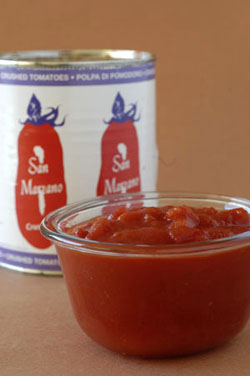
Crushed Tomatoes. All product photography by Dhanraj Emanuel.
|
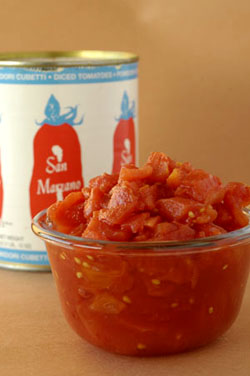
Diced Tomatoes. |
Diced Tomatoes
Crushed tomatoes, polpa di pomodoro, are a beautiful red dice. We added them directly to pasta, rice and omelets, and you can make an easy tomato relish (recipe below) to top grilled fish, chicken, steaks, burgers, etc. There are 25 calories per 1/2 cup.
Also use for:
- Casseroles
- Sauces
- Soups
- Risotto
|
Whole Peeled Tomatoes
These whole tomatoes, pomodori pelati, are works of art, red Easter eggs. Because the tomatoes are whole, they don’t generate their own juice, which is all sealed inside; so tomato juice is added to the can. You can make a sauce (recipe below), but we like them so much, we use them in an unorthodox way—in a salad with cubes of mozzarella and some fresh basil, when tomatoes are out of season. There are 30 calories per 1/2 cup.
Also use:
- In soups
- With other vegetables
- To make stewed tomatoes
- To add drama to a variety of plates
(we served them warm with fresh
herbs along with poached eggs, for example)
|
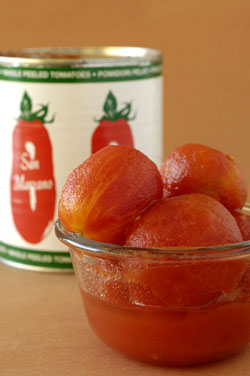
Whole Peeled Tomatoes. |
Tomato Nutrition
Low in calories, high in vitamins and minerals, the tomato (Solanum lycopersicum) is a wonderful fruit. It is a plant in the nightshade (Solanaceae) family, and is a close cousin to chiles, eggplant, the potato and tobacco. The tomato is native to South and Central America, possibly originating in Peru as a yellow cherry tomato. Today, one medium tomato provides 40% of the RDA for vitamin C and a 20% of the RDA for vitamin A (the anti-oxidant beta-carotene). In fact, based on volume of consumption, it is the top contributor of vitamin C and A in the Western diet! It is cholesterol- and sugar-free, low in sodium, very high in dietary fiber (as much as a slice of whole wheat bread), and high in iron, manganese, magnesium, niacin, pantothenic acid, phosphorus, potassium, thiamin and vitamin B6. And, it has all this nutrition for a mere 35 calories per medium tomato. What more could you want? (Great flavor!)
The tomato may also be a life saver. Research studies consistently show that the more 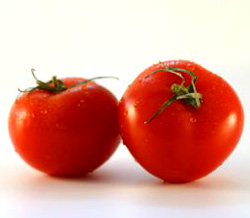 tomatoes, and types of tomato products, people eat, the lower their risks of many different kinds of cancer, including lung, prostate and stomach. This may be due to the lycopene, a disease-fighting phytochemical that makes tomatoes red. Processed tomatoes (e.g. canned tomatoes, tomato sauce, ketchup) contain even more lycopene because cooking breaks down cell walls, releasing and concentrating the carotenoids. TIP: Eating tomatoes with a small amount of fat enables lycopene to be better absorbed. tomatoes, and types of tomato products, people eat, the lower their risks of many different kinds of cancer, including lung, prostate and stomach. This may be due to the lycopene, a disease-fighting phytochemical that makes tomatoes red. Processed tomatoes (e.g. canned tomatoes, tomato sauce, ketchup) contain even more lycopene because cooking breaks down cell walls, releasing and concentrating the carotenoids. TIP: Eating tomatoes with a small amount of fat enables lycopene to be better absorbed.
Photo by Juliane Zielonka | SXC.
Recipes
Diced Tomato Relish
Ingredients
- 1 can (28 ounces) diced tomatoes
- 3 tablespoons extra virgin olive oil
- 3 tablespoons diced fresh basil
- 1 garlic clove, peeled and diced
- 1 tablespoon diced fresh flat-leaf parsley leaves (Italian parsley*)
- 1/4 teaspoon each, salt and pepper (or to taste)
*The Romans were the first to consume this herb in large quantities. It is slightly peppery and more strongly flavored than other common varieties of parsley, including the ubiquitous curly parsley. An excellent source of vitamins A and C, try Italian parsley with beets, cabbage, carrots, onions and turnips, as well as with tomatoes. Because of its high chlorophyll content, it is used as a breath freshener. Purchase bunches whose sprigs are perky and dark green; avoid wilting, browning or yellowing parsley. |
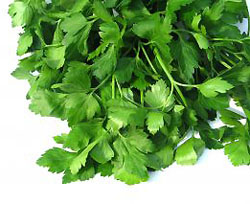
Flat-leaf or “Italian” parsley. Photo by Sanja Gjenero | SXC. |
Preparation
- Place oil and garlic in a medium mixing bowl. Drain the juice from the diced tomatoes and add to the bowl.
- Add the herbs and season with salt and pepper. Mix thoroughly.
- Serve over grilled fish, chicken, steaks, burgers, bruschetta or anything you desire. Serves 6 to 8.
Simple Tomato Sauce
Ingredients
- 1 can (28 ounces) crushed
tomatoes
- 3 tablespoons extra virgin olive oil
- 1 garlic clove, peeled and diced
- 1/4 teaspoon each, salt and pepper (or to taste)
|
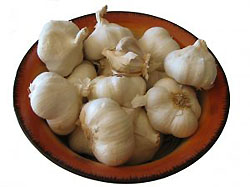
Garlic bulbs. Photo by Brandy Dopkins | SXC. |
Preparation
- Place oil and garlic in a medium sauté pan over medium heat. Cook until the garlic becomes gold in color.
- Add the crushed tomatoes and reduce the heat to low. Stir once and cook uncovered for 20 minutes.
- Add the salt and pepper, and cook for 3 minutes more. Serve over your favorite pasta with your favorite grating cheese (read our article on Italian grating cheeses).
- Serves 4. Note that Italians use a small amount of sauce, focusing their attention on the quality of the pasta.
Tomato & Onion Sauce (Pomodoro Cipolla)
Ingredients
- 1 can (28 ounces) crushed
tomatoes
- 3 tablespoons butter
- 1 chopped onion (small)
- 1/4 teaspoon each, salt and pepper (or to taste)
Preparation |
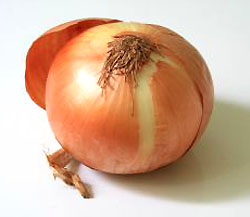
Onion. Photo by Ruben Shito | SXC. |
- Put butter and onion in a 10-inch sauté pan over medium-high heat. Stir for one minute, cover the pan and reduce to low. Cook until the onion is pale yellow, but do not allow it to brown.
- Drain the excess juice from the tomatoes (the San Marzano juice is delicious—drink it!). Add the tomatoes to the pan and increase the heat to medium.
- Add the salt and pepper. Cook for 6 minutes and serve over your favorite pasta. Serves 4.
SAN MARZANO TOMATOES
Crushed, Diced and Whole Peeled
Available at fine food stores nationwide, including Whole Foods Markets. If your retailer doesn’t have them, ask for them to be ordered—they’re really terrific! |
 |
Shipping additional. Prices and flavor availability are verified at publication but are subject to change. Also available at fine supermarkets and specialty stores nationwide.
Lifestyle Direct, Inc. All rights reserved. Images are the copyright of their respective owners.

|



 in 1770, as a gift from the Kingdom of Peru to the Kingdom of Naples (the tomato originated in Peru). The seeds were planted in the area that is the present-day commune of San Marzano, a small town southeast of Naples at the base of Mount Vesuvius. The volcanic soil is believed to act as a filter for water impurities, producing a lower-acidity, brighter-flavored tomato. The tomatoes grown in the San Marzano area have the D.O.P. emblem, Denominazione d’Origine Protetta.
in 1770, as a gift from the Kingdom of Peru to the Kingdom of Naples (the tomato originated in Peru). The seeds were planted in the area that is the present-day commune of San Marzano, a small town southeast of Naples at the base of Mount Vesuvius. The volcanic soil is believed to act as a filter for water impurities, producing a lower-acidity, brighter-flavored tomato. The tomatoes grown in the San Marzano area have the D.O.P. emblem, Denominazione d’Origine Protetta. 



 tomatoes, and types of tomato products, people eat, the lower their risks of many different kinds of cancer, including lung, prostate and stomach. This may be due to the lycopene, a disease-fighting phytochemical that makes tomatoes red. Processed tomatoes (e.g. canned tomatoes, tomato sauce, ketchup) contain even more lycopene because cooking breaks down cell walls, releasing and concentrating the carotenoids. TIP: Eating tomatoes with a small amount of fat enables lycopene to be better absorbed.
tomatoes, and types of tomato products, people eat, the lower their risks of many different kinds of cancer, including lung, prostate and stomach. This may be due to the lycopene, a disease-fighting phytochemical that makes tomatoes red. Processed tomatoes (e.g. canned tomatoes, tomato sauce, ketchup) contain even more lycopene because cooking breaks down cell walls, releasing and concentrating the carotenoids. TIP: Eating tomatoes with a small amount of fat enables lycopene to be better absorbed.


